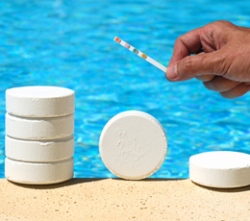Lets try to understand the the Effects of Trichlor and unveil some myths about this very powerful chemical.
Bleach is mostly pH neutral. Some bleach does contain extra sodium hydroxide as a stabilizer, so it depends on the bleach manufacturer. Trichlor is acidic. When using both, you will probably use about 85 % to 95 % bleach and 5 % to 15 % trichlor.
Factors such as water temperature, aeration, pH, TA and cyanuric acid levels will have an effect on the percentages.
You also have to account for the cyanuric acid buildup from using trichlor. As long as the water is carefully maintained, using a combination of liquid chlorine and trichlor can be a good choice.
When dissolved in water, the three chlorine atoms attached to the ring combine with water to form hypochlorous acid where the chlorine on the ring is substituted with hydrogen from water. You can think of it this way where “CY” is the cyanuric ring core:
Cl3CY + 3H2O –> H3CY + 3HOCl
Trichlor + Water –> Cyanuric Acid + Hypochlorous Acid
So when Trichlor dissolves in water, it produces Cyanuric Acid and Hypochlorous Acid. Both Cyanuric Acid and Hypochlorous Acid are weak acids, but in the presence of a pH buffer as found in pool water the distinction between a weak and strong acid doesn’t matter and the net result is that one 8-ounce 3″ tablet/puck of Trichlor is equivalent in acidity as 4.6 fluid ounces of Muriatic Acid (31.45% Hydrochloric Acid).
But that is only half of the story. The Hypochlorous Acid (i.e. chlorine) does not stay around but will either get broken down by sunlight or will oxidizie an organic or ammonia. When this happens, this is an acidic process (for example, when chlorine breaks down in sunlight, it releases oxygen gas and produces hydrochloric acid; when chlorine oxidizes ammonia, it releases nitrogen gas and also produces hydrochloric acid). The chlorine that comes from that same single puck of Trichlor and then breaks down or oxidizes is equivalent to 8.0 fluid ounces of Muriatic Acid.
So the combination of Trichlor dissolving to produce Cyanuric Acid and Hypochlorous Acid plus especially the subsequent using up of the chlorine is highly acidic.
This is also why it is a myth that using bleach or chlorinating liquid will raise the pH. Though it is true that the additional addition of chlorine from such sources will raise the pH, this is almost exactly compensated with the subsequent lowering in pH when the chlorine gets used up. So looking at both chlorine addition and usage, hypochlorite sources of chlorine (bleach, chlorinating liquid, Cal-Hypo, Lithium hypochlorite) are essentially pH neutral.